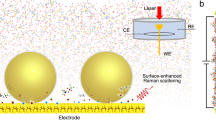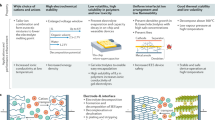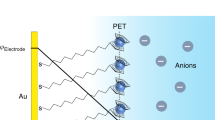Abstract
Driven by the potential applications of ionic liquids (ILs) in many emerging electrochemical technologies, recent research efforts have been directed at understanding the complex ion ordering in these systems, to uncover novel energy storage mechanisms at IL–electrode interfaces. Here, we discover that surface-active ILs (SAILs), which contain amphiphilic structures inducing self-assembly, exhibit enhanced charge storage performance at electrified surfaces. Unlike conventional non-amphiphilic ILs, for which ion distribution is dominated by Coulombic interactions, SAILs exhibit significant and competing van der Waals interactions owing to the non-polar surfactant tails, leading to unusual interfacial ion distributions. We reveal that, at an intermediate degree of electrode polarization, SAILs display optimum performance, because the low-charge-density alkyl tails are effectively excluded from the electrode surfaces, whereas the formation of non-polar domains along the surface suppresses undesired overscreening effects. This work represents a crucial step towards understanding the unique interfacial behaviour and electrochemical properties of amphiphilic liquid systems showing long-range ordering, and offers insights into the design principles for high-energy-density electrolytes based on spontaneous self-assembly behaviour.
This is a preview of subscription content, access via your institution
Access options
Access Nature and 54 other Nature Portfolio journals
Get Nature+, our best-value online-access subscription
$29.99 / 30 days
cancel any time
Subscribe to this journal
Receive 12 print issues and online access
$259.00 per year
only $21.58 per issue
Buy this article
- Purchase on Springer Link
- Instant access to full article PDF
Prices may be subject to local taxes which are calculated during checkout






Similar content being viewed by others
Data availability
The data that support the findings of this study are available from the corresponding authors upon reasonable request.
References
MacFarlane, D. R. et al. Ionic liquids and their solid-state analogues as materials for energy generation and storage. Nat. Rev. Mater. 1, 15005 (2016).
Salanne, M. et al. Efficient storage mechanisms for building better supercapacitors. Nat. Energy 1, 16070 (2016).
Li, Y., Wang, X. G., Dong, S. M., Chen, X. & Cui, G. L. Recent advances in non-aqueous electrolyte for rechargeable Li–O2 batteries. Adv. Energy Mater. 6, 1600751 (2016).
Armand, M., Endres, F., MacFarlane, D. R., Ohno, H. & Scrosati, B. Ionic-liquid materials for the electrochemical challenges of the future. Nat. Mater. 8, 621–629 (2009).
Che, H. Y. et al. Electrolyte design strategies and research progress for room-temperature sodium-ion batteries. Energy Environ. Sci. 10, 1075–1101 (2017).
Fedorov, M. V. & Kornyshev, A. A. Ionic liquids at electrified interfaces. Chem. Rev. 114, 2978–3036 (2014).
Bazant, M. Z., Storey, B. D. & Kornyshev, A. A. Double layer in ionic liquids: overscreening versus crowding. Phys. Rev. Lett. 106, 046102 (2011).
Gebbie, M. A., Dobbs, H. A., Valtiner, M. & Israelachvili, J. N. Long-range electrostatic screening in ionic liquids. Proc. Natl Acad. Sci. USA 112, 7432–7437 (2015).
Zhou, H. et al. Nanoscale perturbations of room temperature ionic liquid structure at charged and uncharged interfaces. ACS Nano 6, 9818–9827 (2012).
Gebbie, M. A. et al. Ionic liquids behave as dilute electrolyte solutions. Proc. Natl Acad. Sci. USA 110, 9674–9679 (2013).
Mezger, M. et al. Molecular layering of fluorinated ionic liquids at a charged sapphire (0001) surface. Science 322, 424–428 (2008).
Crowhurst, L., Lancaster, N. L., Arlandis, J. M. P. & Welton, T. Manipulating solute nucleophilicity with room temperature ionic liquids. J. Am. Chem. Soc. 126, 11549–11555 (2004).
Zhang, S. G., Zhang, J. H., Zhang, Y. & Deng, Y. Q. Nanoconfined ionic liquids. Chem. Rev. 117, 6755–6833 (2017).
Elbourne, A., Voitchovsky, K., Warr, G. G. & Atkin, R. Ion structure controls ionic liquid near-surface and interfacial nanostructure. Chem. Sci. 6, 527–536 (2015).
Lopes, J. N. A. C. & Padua, A. A. H. Nanostructural organization in ionic liquids. J. Phys. Chem. B 110, 3330–3335 (2006).
Padua, A. A. H., Gomes, M. F. & Lopes, J. N. A. C. Molecular solutes in ionic liquids: a structural perspective. Acc. Chem. Res. 40, 1087–1096 (2007).
Dong, K., Liu, X. M., Dong, H. F., Zhang, X. P. & Zhang, S. J. Multiscale studies on ionic liquids. Chem. Rev. 117, 6636–6695 (2017).
McDonald, S., Murphy, T., Imberti, S., Warr, G. G. & Atkin, R. Amphiphilically nanostructured deep eutectic solvents. J. Phys. Chem. Lett. 9, 3922–3927 (2018).
Brown, P. et al. Anionic surfactant ionic liquids with 1-butyl-3-methyl-imidazolium cations: characterization and application. Langmuir 28, 2502–2509 (2012).
Kim, Y. K., Wang, X. G., Mondkar, P., Bukusoglu, E. & Abbott, N. L. Self-reporting and self-regulating liquid crystals. Nature 557, 539–544 (2018).
Futamura, R. et al. Partial breaking of the Coulombic ordering of ionic liquids confined in carbon nanopores. Nat. Mater. 16, 1225–1232 (2017).
Mefford, J. T., Hardin, W. G., Dai, S., Johnston, K. P. & Stevenson, K. J. Anion charge storage through oxygen intercalation in LaMnO3 perovskite pseudocapacitor electrodes. Nat. Mater. 13, 726–732 (2014).
Xia, Y. et al. Thickness-independent capacitance of vertically aligned liquid-crystalline MXenes. Nature 557, 409–412 (2018).
Zhong, C. et al. A review of electrolyte materials and compositions for electrochemical supercapacitors. Chem. Soc. Rev. 44, 7484–7539 (2015).
Smith, A. M. et al. Monolayer to bilayer structural transition in confined pyrrolidinium-based ionic liquids. J. Phys. Chem. Lett. 4, 378–382 (2013).
Kornyshev, A. A. Double-layer in ionic liquids: paradigm change? J. Phys. Chem. B 111, 5545–5557 (2007).
Pak, A. J., Paekw, E. & Hwang, G. S. Relative contributions of quantum and double layer capacitance to the supercapacitor performance of carbon nanotubes in an ionic liquid. Phys. Chem. Chem. Phys. 15, 19741–19747 (2013).
Merlet, C. et al. On the molecular origin of supercapacitance in nanoporous carbon electrodes. Nat. Mater. 11, 306–310 (2012).
Fedorov, M. V., Georgi, N. & Kornyshev, A. A. Double layer in ionic liquids: the nature of the camel shape of capacitance. Electrochem. Commun. 12, 296–299 (2010).
Georgi, N., Kornyshev, A. A. & Fedorov, M. V. The anatomy of the double layer and capacitance in ionic liquids with anisotropic ions: electrostriction vs. lattice saturation. J. Electroanal. Chem. 649, 261–267 (2010).
Perkin, S. et al. Self-assembly in the electrical double layer of ionic liquids. Chem. Commun. 47, 6572–6574 (2011).
Hayes, R., Warr, G. G. & Atkin, R. Structure and nanostructure in ionic liquids. Chem. Rev. 115, 6357–6426 (2015).
Espinosa-Marzal, R. M., Han, M., Arcifa, A., Spencer, N. D. & Rossi, A. in Encyclopedia of Interfacial Chemistry (ed. Wandelt, K.) 172–194 (Elsevier, 2018).
Werzer, O., Cranston, E. D., Warr, G. G., Atkin, R. & Rutland, M. W. Ionic liquid nanotribology: mica–silica interactions in ethylammonium nitrate. Phys. Chem. Chem. Phys. 14, 5147–5152 (2012).
Voïtchovsky, K. Anharmonicity, solvation forces, and resolution in atomic force microscopy at the solid–liquid interface. Phys. Rev. E 88, 022407 (2013).
Lin, X., Salari, M., Arava, L. M. R., Ajayan, P. M. & Grinstaff, M. W. High temperature electrical energy storage: advances, challenges, and frontiers. Chem. Soc. Rev. 45, 5848–5887 (2016).
Simon, P. & Gogotsi, Y. Capacitive energy storage in nanostructured carbon–electrolyte systems. Acc. Chem. Res. 46, 1094–1103 (2013).
Pech, D. et al. Ultrahigh-power micrometre-sized supercapacitors based on onion-like carbon. Nat. Nanotechnol. 5, 651–654 (2010).
Xie, K. et al. Carbon nanocages as supercapacitor electrode materials. Adv. Mater. 24, 347–352 (2012).
Mao, X. et al. Microwave-assisted oxidation of electrospun turbostratic carbon nanofibers for tailoring energy storage capabilities. Chem. Mater. 27, 4574–4585 (2015).
Mao, X. W., Simeon, F., Rutledge, G. C. & Hatton, T. A. Electrospun carbon nanofiber webs with controlled density of states for sensor applications. Adv. Mater. 25, 1309–1314 (2013).
Li, J. C., Ma, C., Chi, M. F., Liang, C. D. & Dudney, N. J. Solid electrolyte: the key for high-voltage lithium batteries. Adv. Energy Mater. 5, 1401408 (2015).
Alshammary, B., Walsh, F. C., Herrasti, P. & Ponce de Leon, C. Electrodeposited conductive polymers for controlled drug release: polypyrrole. J. Solid State Electrochem. 20, 839–859 (2016).
Stern, M. C., Simeon, F., Herzog, H. & Hatton, T. A. Post-combustion carbon dioxide capture using electrochemically mediated amine regeneration. Energy Environ. Sci. 6, 2505–2517 (2013).
Wang, L. D. et al. Molecular valves for controlling gas phase transport made from discrete angstrom-sized pores in graphene. Nat. Nanotechnol. 10, 785–790 (2015).
Hou, X., Hu, Y. H., Grinthal, A., Khan, M. & Aizenberg, J. Liquid-based gating mechanism with tunable multiphase selectivity and antifouling behaviour. Nature 519, 70–73 (2015).
Mao, X., Guo, F., Yan, E. H., Rutledge, G. C. & Hatton, T. A. Remarkably high heterogeneous electron transfer activity of carbon-nanotube-supported reduced graphene oxide. Chem. Mater. 28, 7422–7432 (2016).
Canongia Lopes, J. N., Deschamps, J. & Padua, A. A. H. Modeling ionic liquids using a systematic all-atom force field. J. Phys. Chem. B 108, 2038–2047 (2004).
Kaminski, G. A. & Jorgensen, W. L. Host–guest chemistry of rotaxanes and catenanes: application of a polarizable all-atom force field to cyclobis(paraquat-p-phenylene) complexes with disubstituted benzenes and biphenyls. J. Chem. Soc. Perkin Trans. 2, 2365–2375 (1999).
Canongia Lopes, J. N. & Padua, A. A. H. CL&P: a generic and systematic force field for ionic liquids modeling. Theor. Chem. Acc. 131, 1129 (2012).
Canongia Lopes, J. N., Pádua, A. A. H. & Shimizu, K. Molecular force field for ionic liquids IV: trialkylimidazolium and alkoxycarbonyl-imidazolium cations; alkylsulfonate and alkylsulfate anions. J. Phys. Chem. B 112, 5039–5046 (2008).
Price, M. L. P., Ostrovsky, D. & Jorgensen, W. L. Gas-phase and liquid-state properties of esters, nitriles, and nitro compounds with the OPLS-AA force field. J. Comput. Chem. 22, 1340–1352 (2001).
Girifalco, L. A., Hodak, M. & Lee, R. S. Carbon nanotubes, buckyballs, ropes, and a universal graphitic potential. Phys. Rev. B 62, 13104–13110 (2000).
Plimpton, S. Fast parallel algorithms for short-range molecular dynamics. J. Comp. Phys. 117, 1–19 (1995).
Tuckerman, M. E., Alejandre, J., Lopez-Rendon, R., Jochim, A. L. & Martyna, G. J. A liouville-operator derived measure-preserving integrator for molecular dynamics simulations in the isothermal-isobaric ensemble. J. Phys. A Math. Gen. 39, 5629–5651 (2006).
Hockney, R. W. & Eastwood, J. W. Computer Simulation Using Particles (Taylor & Francis, 1988).
Ryckaert, J. P., Ciccotti, G. & Berendsen, H. J. C. Numerical integration of the cartesian equations of motion of a system with constraints—molecular dynamics of n-alkanes. J. Comp. Phys. 23, 327–341 (1977).
Siepmann, J. I. & Sprik, M. Influence of surface topology and electrostatic potential on water/electrode systems. J. Chem. Phys. 102, 511–524 (1995).
Reed, S. K., Lanning, O. J. & Madden, P. A. Electrochemical interface between an ionic liquid and a model metallic electrode. J. Chem. Phys. 126, 084704 (2007).
Wang, Z., Yang, Y., Olmsted, D. L., Asta, M. & Laird, B. B. Evaluation of the constant potential method in simulating electric double-layer capacitors. J. Chem. Phys. 141, 184102 (2014).
Acknowledgements
This work was supported by an MIT Energy Initiative seed grant. X.M. acknowledges financial support from an MIT Skoltech fellowship. C.Č. acknowledges financial support from the Czech Science Foundation (GACR number 19-04150Y). C.Č. and A.A.H.P. thank A. Dequidt of Université Clermont Auvergne for use of the computer program to calculate structure factors. We thank the UK research council STFC for providing beam time at the Institut Laue–Langevin, Grenoble, France. Small-angle neutron scattering experiments were supported under proposal number 9-12-434. X-ray reflectivity measurements were performed at Stanford Synchrotron Radiation Lightsource, SLAC National Accelerator Laboratory, which is supported by the US Department of Energy, Office of Science, Office of Basic Energy Sciences, under contract no. DE-AC02-76SF00515.
Author information
Authors and Affiliations
Contributions
X.M. and P.B. conceived the initial idea. X.M. designed and led the research, carried out the electrochemical experiments, and analysed the experimental and simulation data, under the supervision of T.A.H. P.B. synthesized the SAILs and contributed to the electrochemical experiments, under the supervision of T.A.H. C.Č. carried out the molecular dynamics simulations under the supervision of A.A.H.P. and M.F.C.G. G.H. performed the SANS experiments under the supervision of J.E. and I.G. H.L. performed the AFM force measurements under the supervision of R.A. Y.R. contributed to the synthesis of the SAILs and X-ray reflectivity measurements. D.C. performed the X-ray reflectivity measurements. X.M. wrote the manuscript. All authors revised the manuscript.
Corresponding authors
Ethics declarations
Competing interests
X.M., P.B., M.F.C.G. and T.A.H. have filed a patent application based on this work (US Patent application number 16/323,468). This patent, entitled ‘High-temperature supercapacitors containing surface active ionic liquids’ was filed with the US Patent and Trademark Office on 5 February 2019, and published on 20 June 2019 with publication number US-2019-0189364-A1.
Additional information
Publisher’s note: Springer Nature remains neutral with regard to jurisdictional claims in published maps and institutional affiliations.
Supplementary information
Supplementary Information
Supplementary Notes 1–9, Tables 1–6, Figs. 1–15 and references 1–32
Rights and permissions
About this article
Cite this article
Mao, X., Brown, P., Červinka, C. et al. Self-assembled nanostructures in ionic liquids facilitate charge storage at electrified interfaces. Nat. Mater. 18, 1350–1357 (2019). https://doi.org/10.1038/s41563-019-0449-6
Received:
Accepted:
Published:
Issue Date:
DOI: https://doi.org/10.1038/s41563-019-0449-6
This article is cited by
-
Ionic liquids on uncharged and charged surfaces: In situ microstructures and nanofriction
Friction (2022)
-
Recovering the electrochemical window by forming a localized solvation nanostructure in ionic liquids with trace water
Science China Chemistry (2022)
-
Electrode material–ionic liquid coupling for electrochemical energy storage
Nature Reviews Materials (2020)
-
Perspectives for electrochemical capacitors and related devices
Nature Materials (2020)
-
Engineering high-energy-density sodium battery anodes for improved cycling with superconcentrated ionic-liquid electrolytes
Nature Materials (2020)



